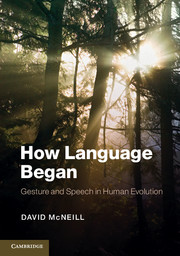Book contents
- Frontmatter
- Contents
- List of figures
- List of tables
- Preface – Out on a limb
- Acknowledgments
- 1 INTRODUCTION – GESTURE AND THE ORIGIN OF LANGUAGE
- 2 What evolved (in part) – the growth point
- 3 How it evolved (in part) – Mead's Loop
- 4 Effects of Mead's Loop
- 5 Ontogenesis in evolution – evolution in ontogenesis
- 6 Alternatives, their limits, and the science base of the growth point
- Notes
- References
- Index
4 - Effects of Mead's Loop
Published online by Cambridge University Press: 05 October 2012
- Frontmatter
- Contents
- List of figures
- List of tables
- Preface – Out on a limb
- Acknowledgments
- 1 INTRODUCTION – GESTURE AND THE ORIGIN OF LANGUAGE
- 2 What evolved (in part) – the growth point
- 3 How it evolved (in part) – Mead's Loop
- 4 Effects of Mead's Loop
- 5 Ontogenesis in evolution – evolution in ontogenesis
- 6 Alternatives, their limits, and the science base of the growth point
- Notes
- References
- Index
Summary
Language, the fact of it, that it evolved, changed everything; how we communicate of course, but also how we act, think, become conscious, and live in social and cultural groups – whole spans of human life. I do not mean simply that since we speak, language is part of life but that these domains could not exist at all in the forms they take if mind and the mode of being that language shapes had not also evolved. My standpoint has been the mental and how the origin of language shaped it but the scale of change is much broader. This chapter is made up of 14 essays stemming mostly from Chapter 3, describing modern-day Mead's Loop effects – mental, actional, artistic, and social. The chapter is a kind of “gumbo,” a pot of leftovers, tasty, boiling, and not to be missed. I have endeavored to order the essays so that earlier ones fulfill presuppositions that later ones make, but otherwise the essays are self-contained.
While Mead's Loop is not causally involved in each of the following, it created conditions whereby they emerged, as is fitting for a founding event. The chapter as a whole demonstrates that small changes – mirror neurons becoming responsive to one's own gestures as if from another – can, over time, set in motion a wide range of consequences. Also, as a matter of scientific interest, since none of these consequences was foreseen, they count as “discoveries” by the Mead's Loop hypothesis and so as a kind of confirmation of it. I have divided them into “direct” and “indirect” effects. Mead's Loop can be said to have been a cause of the direct group effects. They of course have been vastly elaborated culturally and historically, but still Mead's Loop can be seen to have played a causal role. The second group is no less indebted to Mead's Loop but other factors have had greater weight, and so are deemed “indirect.”
Information
- Type
- Chapter
- Information
- How Language BeganGesture and Speech in Human Evolution, pp. 114 - 164Publisher: Cambridge University PressPrint publication year: 2012
